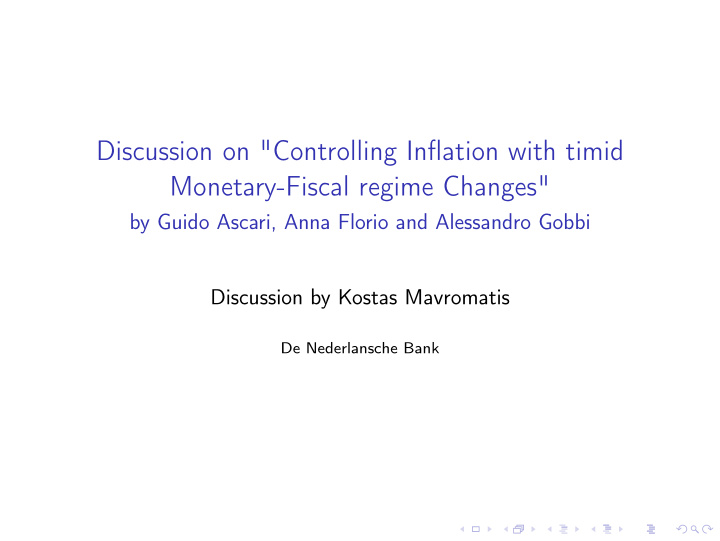



Discussion on "Controlling Inflation with timid Monetary-Fiscal regime Changes" by Guido Ascari, Anna Florio and Alessandro Gobbi Discussion by Kostas Mavromatis De Nederlansche Bank
Literature ◮ Inflation and FP: Bhattarai et al. (2014), Leeper (1991), Sims (2011). ◮ MP-FP mix and MS: Bianchi & Ilut (2017), Bianchi & Melosi (2013), Bianchi (2012), Davig and Leeper (2011) .
This Paper ◮ Characterization of the properties of the model when MP and FP switch over time. ◮ Long-run fiscal principle; conditions FP needs to satisfy for a unique RE equilibrium in a MS environment. ◮ Coordination: MP and FP coordination within and across regimes.
Results ◮ Classification of deviations 1. Overall AM/PF mix : only timid deviations from initial stance. 2. Overall switching mix : substantial switch in both MP and FP. ◮ No wealth effects, even after timid deviations and full knowledge. ◮ Wealth effects, under substantial deviations.
Long-Run Fiscal Principle ◮ Given an active MP, FP is such that no wealth effects exist in either regime. ◮ A "well behaved" MP allows for timid deviations in FP, and the dynamics remain Ricardian.
Digging into the Results ◮ Given a symmetric regime duration, asymmetric deviations can lead to indeterminacy. ◮ An overall passive FP needs to be accompanied by an overall active MP to yield determinacy of the global equilibrium. ◮ Symmetry in deviation is important; this can lead to determinacy of the global equilibrium even if the economy is switching between an AM/AF and a PM/PF. ◮ Long-Run Taylor Principle fails when FP is not overall passive. ◮ In a MS environment the intervals of the MP and FP coefficients widen. This is because of the prob of a switch (and hence because of agents’ beliefs).
Policy Implications ◮ Timidity trap; substantial policy deviations from an AM/PF regime necessary to reflate the economy (assuming no distortionary taxes etc...) ◮ Normal Times; AM/PF dominant regime in order to anchor inflation expectations even when the economy switches temporarily to a PM/AF regime. ◮ ZLB; substantial deviations in FP as well to get determinacy when ZLB is short lived. Calendar-based forward guidance associated with persistent deviations from an AM/PF regime.
Comments ◮ Can probabilities be such to allow for asymmetries in the two policies (asymmetric deviations)? ◮ Can you distinguish between a switching mix with low probability and an overall AM/PF mix ? ◮ Are you really identifying the ZLB by setting γ π = 0? ◮ Not so sure about the connection between the BVAR and your theoretical IRFs. ◮ Davig & Leeper (2007) solve the model differently so new conditions on the MPF might be needed.
Recommend
More recommend